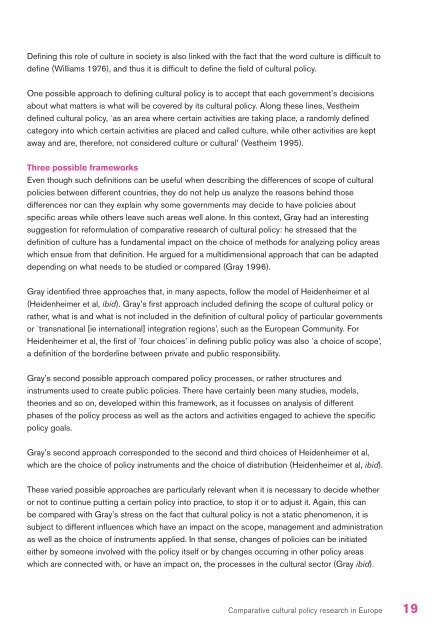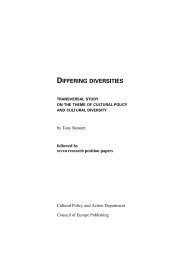Why we need European cultural policies: the impact of EU ...
Why we need European cultural policies: the impact of EU ...
Why we need European cultural policies: the impact of EU ...
Create successful ePaper yourself
Turn your PDF publications into a flip-book with our unique Google optimized e-Paper software.
Defining this role <strong>of</strong> culture in society is also linked with <strong>the</strong> fact that <strong>the</strong> word culture is difficult todefine (Williams 1976), and thus it is difficult to define <strong>the</strong> field <strong>of</strong> <strong>cultural</strong> policy.One possible approach to defining <strong>cultural</strong> policy is to accept that each government’s decisionsabout what matters is what will be covered by its <strong>cultural</strong> policy. Along <strong>the</strong>se lines, Ves<strong>the</strong>imdefined <strong>cultural</strong> policy, `as an area where certain activities are taking place, a randomly definedcategory into which certain activities are placed and called culture, while o<strong>the</strong>r activities are keptaway and are, <strong>the</strong>refore, not considered culture or <strong>cultural</strong>’ (Ves<strong>the</strong>im 1995).Three possible frameworksEven though such definitions can be useful when describing <strong>the</strong> differences <strong>of</strong> scope <strong>of</strong> <strong>cultural</strong><strong>policies</strong> bet<strong>we</strong>en different countries, <strong>the</strong>y do not help us analyze <strong>the</strong> reasons behind thosedifferences nor can <strong>the</strong>y explain why some governments may decide to have <strong>policies</strong> aboutspecific areas while o<strong>the</strong>rs leave such areas <strong>we</strong>ll alone. In this context, Gray had an interestingsuggestion for reformulation <strong>of</strong> comparative research <strong>of</strong> <strong>cultural</strong> policy: he stressed that <strong>the</strong>definition <strong>of</strong> culture has a fundamental <strong>impact</strong> on <strong>the</strong> choice <strong>of</strong> methods for analyzing policy areaswhich ensue from that definition. He argued for a multidimensional approach that can be adapteddepending on what <strong>need</strong>s to be studied or compared (Gray 1996).Gray identified three approaches that, in many aspects, follow <strong>the</strong> model <strong>of</strong> Heidenheimer et al(Heidenheimer et al, ibid). Gray’s first approach included defining <strong>the</strong> scope <strong>of</strong> <strong>cultural</strong> policy orra<strong>the</strong>r, what is and what is not included in <strong>the</strong> definition <strong>of</strong> <strong>cultural</strong> policy <strong>of</strong> particular governmentsor `transnational [ie international] integration regions’, such as <strong>the</strong> <strong>European</strong> Community. ForHeidenheimer et al, <strong>the</strong> first <strong>of</strong> `four choices’ in defining public policy was also `a choice <strong>of</strong> scope’,a definition <strong>of</strong> <strong>the</strong> borderline bet<strong>we</strong>en private and public responsibility.Gray’s second possible approach compared policy processes, or ra<strong>the</strong>r structures andinstruments used to create public <strong>policies</strong>. There have certainly been many studies, models,<strong>the</strong>ories and so on, developed within this framework, as it focusses on analysis <strong>of</strong> differentphases <strong>of</strong> <strong>the</strong> policy process as <strong>we</strong>ll as <strong>the</strong> actors and activities engaged to achieve <strong>the</strong> specificpolicy goals.Gray’s second approach corresponded to <strong>the</strong> second and third choices <strong>of</strong> Heidenheimer et al,which are <strong>the</strong> choice <strong>of</strong> policy instruments and <strong>the</strong> choice <strong>of</strong> distribution (Heidenheimer et al, ibid).These varied possible approaches are particularly relevant when it is necessary to decide whe<strong>the</strong>ror not to continue putting a certain policy into practice, to stop it or to adjust it. Again, this canbe compared with Gray’s stress on <strong>the</strong> fact that <strong>cultural</strong> policy is not a static phenomenon, it issubject to different influences which have an <strong>impact</strong> on <strong>the</strong> scope, management and administrationas <strong>we</strong>ll as <strong>the</strong> choice <strong>of</strong> instruments applied. In that sense, changes <strong>of</strong> <strong>policies</strong> can be initiatedei<strong>the</strong>r by someone involved with <strong>the</strong> policy itself or by changes occurring in o<strong>the</strong>r policy areaswhich are connected with, or have an <strong>impact</strong> on, <strong>the</strong> processes in <strong>the</strong> <strong>cultural</strong> sector (Gray ibid).Comparative <strong>cultural</strong> policy research in Europe19














